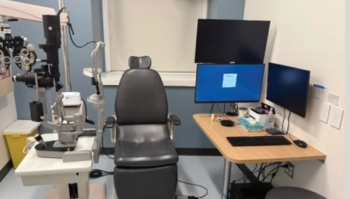
Stent inject + cataract surgery effective in reducing IOP, burden
System preloaded with two trabecular bypass stents for ab interno implantation
Multiple lateral outlet lumens in both stents facilitate outflow of aqueous in the canal. The dual-stent design allows access to more collector channels.
Reviewed by Thomas W. Samuelson, MD
Implementation of a
Multiple lateral outlet lumens in both stents facilitate outflow of aqueous in the canal. The dual-stent design allows access to more collector channels, according to Thomas W. Samuelson, MD, adjunct professor, University of Minnesota, and in private practice at Minnesota Eye Consultants, Minneapolis. Dr. Samuelson demonstrated how such intracanal devices communicate with the collector system and the episcleral vasculature.
When the IOP is increased in an eye, for example, during infusion with balanced salt solution during irrigation and aspiration, no influx of blood (reflux) is seen as the gradient for fluid flow is from inside the eye to out. When the IOP is lowered below the episcleral venous pressure, reflux of blood is seen from the lumen of the
“This is the best confirmation that the stents are in communication with the episcleral vasculature and the network of vessels and outflow channels,” he said.
Study design
The inject system was evaluated in a prospective, randomized pivotal study to determine the safety and efficacy of this second-generation trabecular microbypass stent that was implanted during cataract surgery. Patients were included who had a surgical cataract as well as mild-to-moderate primary open-angle glaucoma with an IOP of 24 mm Hg or lower while on treatment with one to three medications. After a medication washout phase, the mean diurnal IOPs (DIOPs) ranged from 21 to 36 mm Hg.
Patients were randomly assigned 3:1 to receive the inject device and phacoemulsification (n = 387 patients) or phacoemulsification alone (118 patients). Patients were followed for up to 2 years with annual washouts. The study was conducted at 41 sites in the United States.
The primary endpoint was a 20% or greater decrease in the DIOP; the secondary outcome was a mean reduction in the DIOP. An important factor in this study was the number of stents actually implanted. The study design called for implantation of two stents, which occurred in 98% of the patients randomly assigned to the inject device and phaco group.
Seven patients in that group did not receive two stents; four received three stents as the result of over-implantation; two received one stent because of poor visualization; and one patient did not receive a stent because of failure to cooperate.
Results are promising
Dr. Samuelson reported that at 24 months, 75.8% of patients in the iStent inject and phaco group achieved a 20% reduction in the unmedicated DIOP compared to baseline, while 61.9% achieved this endpoint in the group that underwent phaco alone. The difference in the percentages reached significance (p = 0.003).
The mean unmedicated reduction in the DIOP in the combination group was 7.0 mm Hg compared with 5.4 mm Hg in the phacoemulsification alone group, a difference that also reached significance (p < 0.001), according to Dr. Samuelson.
Specifically, the mean change in the unmedicated IOP in the combination therapy was a 31% decrease from the baseline mean of 24.8 mm Hg to 17.1 mm Hg at 24 months. A look at the number of patients in the inject system and phaco group who achieved an unmedicated DIOP below 18 mm Hg showed that 63.2% did so compared to 50% in the phaco alone group.
The investigators also saw a dramatic reduction, by 50%, in the treatment burden between the two study groups. Preoperatively, the patients in the inject system and phaco group were taking a mean of 1.6 medications that decreased to 0.4 medication postoperatively, for a 75% reduction. In the phaco alone group, the medication use decreased from 1.5 medications preoperatively to 0.8 medication postoperatively, a 47% reduction.
Dr. Samuelson also pointed out that the combination procedure was extremely safe, with “no important differences in the safety profiles between the two study groups.” The investigators published their results in Ophthalmology https://doi.org/10.1016/j. ophtha.2019.03.006
Other considerations
The study under discussion is not the first to demonstrate the beneficial effects of the use of multiple stents compared with the use of a single stent, Dr. Samuelson noted.
“Although the [inject device] was approved recently by the FDA, 30,000 stents have been implanted worldwide,” he explained. “Prospective studies and the real-world experience have shown long-term safety and sustained IOP-lowering and medication-reducing effects. This study met both the primary and secondary effectiveness end points.”
At 24 months, the patients who received the iStent inject implant achieved clinical and significant reductions in the untreated DIOP. The unmedicated IOP of 17.1 mm Hg at that time point is comparable to or lower than IOPs achieved in other randomized clinical trials of minimally invasive glaucoma surgeries.
The overall safety profile associated with use of the iStent inject implant is similar to that of cataract surgery alone,” Dr. Samuelson concluded.
Disclosures:
Thomas W. Samuelson, MD
E: [email protected]
Dr. Samuelson is a consultant to and investigator for Glaukos as well as several other companies in the surgical glaucoma space.
Newsletter
Get the essential updates shaping the future of pharma manufacturing and compliance—subscribe today to Pharmaceutical Technology and never miss a breakthrough.















































